Ava Carter, Anneli Medina
How are plants depicted through different mediums in East Asian Art?
How do Asian artists explore the connection between the natural world and humanity through their work?
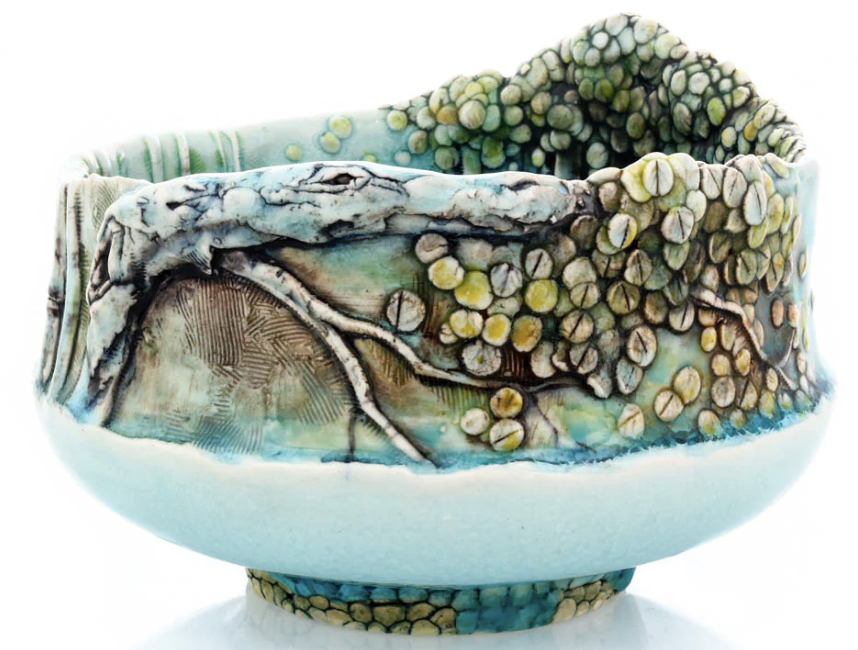
Portrayals of Plants In East Asian Art
This exhibition displays the nuanced ways plants can be intertwined with Asian Art. From the very beginning of art up until modern day, nature has always been a key aspect, and we wanted to explore that more through this exhibition. We specifically choose to focus on the flora of the scenes because they are often the most prominent. Plants in East Asian art serve as a multifaceted lens through which to explore the core question of “What is Asian Art?” By examining the cultural diversity, and artistic techniques inherent in the portrayal of nature, we can gain a deeper understanding of the complex interplay between culture, creativity, and the natural world in Asian artistic traditions. Artists across Asia have developed unique methods for capturing the beauty and essence of the natural world. By studying these techniques and mediums, we can gain an appreciation for the technical skill, craftsmanship, and artistic innovation in Asian art forms.
Asian art frequently celebrates and appreciates the beauty of nature and specifically plants. Landscape paintings, such as those found in traditional Chinese, Japanese and Korean art, often display encapsulating beautiful gardens, tranquil forests, and peaceful landscapes incorporating various plants and flowers. Many Asian artworks depict plants according to the seasons, reflecting the many cycles of nature and their relation to time passing. The portrayal of plants in East Asian art reflects a deep celebration of nature and a connection to cultural traditions and beliefs found in the natural world.
For this exhibition we chose a specific timeline, to show how East Asian Art has evolved over time, from well before the 15th century to modern day, and how throughout this time even as technology has advanced, the importance of plants to humans (and vice versa) has remained the same. Whether Asian artists are working with materials sourced from nature, such as ink, paper, silk, wood, and clay, or deriving their inspiration from landscapes, Asian Art often has strong ties to nature due to many different cultural, philosophical, and aesthetic influences.

(Creator: Unknown)
Material: Stoneware and celadon glaze
(Size: H. 9 ¼ in. W. 9 7/8 in)
Date/period: (13th Century)
Culture/Location: Korea
Source: The Met
This wine ewer with detailed floral designs, displays nature in a delicate way. The etchings of Chrysanthemums and Lotus flowers hold significant cultural and symbolic references to purity, enlightenment, and beauty. The light teal color also adds to the overall tranquility of the ewer and the gentle aesthetic displaying nature and specifically flowers. The ewer reflects the traditional Asian ceramic form, with a plump body, a slim neck, and a slightly curved spout. The handle looks to be designed for comfort as well as beauty. The ewer demonstrates elements that are not only functional but also aesthetically pleasing, which show the intention for Asian art to focus on pleasure and radiance. The Chrysanthemums and lotus flowers that are the focal point of the ewer, both have significant symbolism. Chrysanthemums symbolize longevity, endurance, and nobility in Korean culture, while lotus flowers represent purity, enlightenment, and overall beauty. The intricate detailing and realisticness of these flowers shows the skillful technique of the artist.
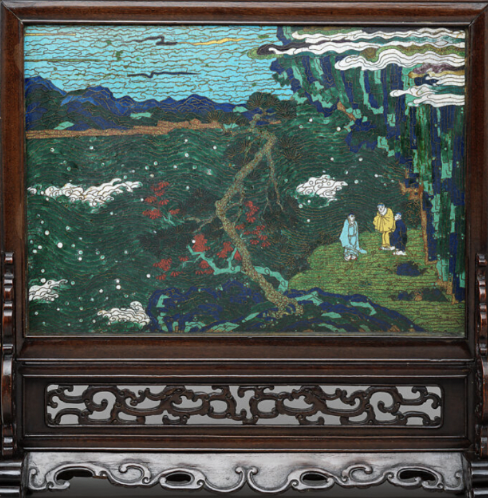
Title: Table screen with landscape
Date/Period: 15th century, Ming dynasty (1368–1644)
Culture: China
Medium: Wood frame and stand
Dimensions: H. 19 3/8 in. (49.2 cm); W. 19 1/8 in. (48.6 cm)
Source: The Met
This table screen stands out due to the amount of colors that are present. Colors in nature are often depicted in a harmonious composition, reflecting the balance found in the natural world. This harmony is symbolic of the interconnected relationship between humans and nature, emphasizing the importance of living in accordance with natural rhythms. The table screen displays a harmonious and tranquil landscape scene. The many representations of flora all come together perfectly. The specific elements of plants are placed to create a balanced and aesthetically pleasing composition that guides the viewer’s gaze thoughtfully through the scene.
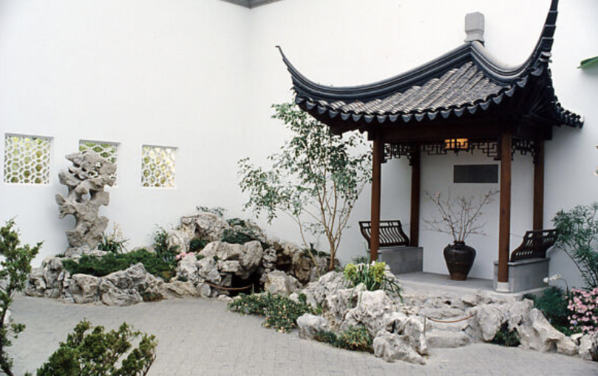
“The Astor Chinese Court”
Artist: Unknown
Date/period: 17th century, Ming dynasty (1368–1644)
Culture/location: China
Medium: Architecture, Taihu rocks, granite terrace, ceramic tile flooring, roof tiles, and door frames, various woods (nan wood columns, pine beams, gingko latticework), brass fittings
Source: The Met
One of the most striking features of the Astor Chinese Court is its use of natural materials, including wood, stone, and bamboo, which are carefully crafted and arranged to create a sense of organic tranquility. The room is also filled with lush greenery, such as plants and small trees, further enhancing the connection to the natural world. In this room nature is depicted with meticulous attention to detail, capturing the beauty and serenity of landscapes, flora, and fauna. The artifacts within the Astor Chinese Court are thoughtfully arranged in a delicately curated manner to highlight their beauty and significance. The objects seem to be organized in a way that shows off the ample space between each item to allow for deep contemplation and appreciation.
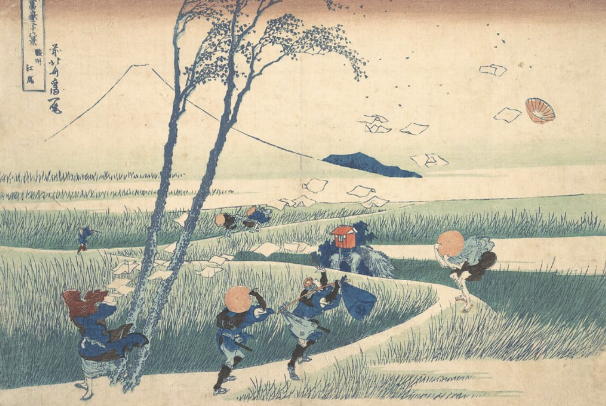
“Ejiri in Suruga Province”
Artist: Katsushika Hokusai
Date/period: ca. 1830–32, Edo period (1615–1868)
Culture/location: Japan
Medium: Woodblock print; ink and color on paper
Source: The Met
In this print nature is depicted as majestic with mount fuji commanding the background as a symbol of strength. One notable aspect of Hokusai’s depiction of nature is his use of perspective and composition to create a sense of depth. Hokusai skillfully captures the conditions of the scene, using subtle gradations of color and shading to convey the changing light. The intricate brush strokes that make up the grass, showcase how much care went into the piece. The blades of glass portray nature and specifically plants in an extremely delicate and even peaceful way.

(Creator: Yayoi Kusama)
Material: Screenprint
(Size: H 45cm x W 53cm)
Date/period: (1985)
Culture/Location: Japan
Source: The Observer
The contrasting light and dark colors as well as shapes are extremely prevalent within the print. The background being a darker black and purple with many intricate intertwining lines, allow for the bright green and yellow flowers to bounce off of the flat surface catching the audiences eye. This print portrays nature in a surreal and abstract manner rather than a realistic and simple one. Kusama’s works are known for their jumpy and eye-catching colors. “Dandelions” features those exact colors in a way that also calls upon the colors of real dandelion flowers. These bold colors create visual impact and intensity and draw viewers into the artwork. Dandelions are a correct correlation to the natural world which shows Kusama’s love and appreciation for plants and nature in art. The dandelions appear as if they are blossoming in front of your eyes, evoking a sense of growth, vitality, and rebirth.

Artist: Yang Fudoo
Date/period: 2005
Culture/location: China
Medium: Video
Source: Asia Society
This photo is taken from a video, made by Yang Fudoo. The phrase “Seven Intellectuals In a Bamboo Forest.” However is taken from famous Chinese literary and artistic motifs originating from the third century CE during the Wei and Jin dynasties. In “Seven Intellectuals in a Bamboo Forest,” the bamboo forest serves as a metaphorical space of freedom for the intellectuals who have chosen to withdraw from mainstream society. The bamboo forest symbolizes a refuge from the pressures, constraints, and expectations of the outside world. This video is pivotal in showing the importance of a human connection to nature. The bamboo forest serves as a sanctuary where humans can find solace, inspiration, and interact with like-minded individuals. In “Seven Intellectuals in a Bamboo Forest,” the bamboo forest serves as a metaphorical space of freedom for the intellectuals who have chosen to withdraw from mainstream society. The bamboo forest symbolizes a refuge from the pressures, constraints, and expectations of the outside world. This video is pivotal in showing the importance of a human connection to nature. The bamboo forest serves as a sanctuary where humans can find solace, inspiration, and interact with like-minded individuals. [DL: I don’t see any bamboo in the photograph?]
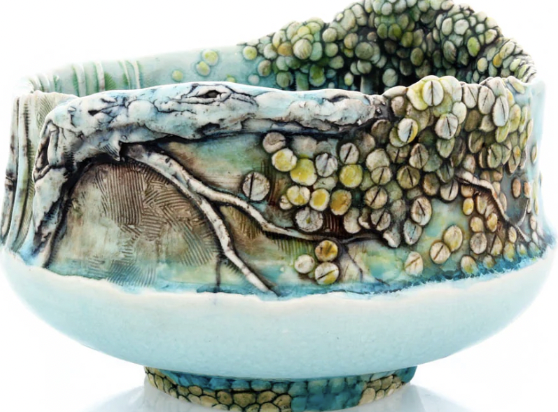
(Creator: Heesoo Lee)
Material: Porcelain
(Size: 7 x 7 x 4.5” H)
Date/period: (2022)
Culture/Location: Unknown
Source: Clayakar
The “Landscape Bowl” displays the vibrant colors and unique textures that create a beautiful portrayal of nature. The intricate designs, cool colored glazing, and seasonal essence, all reflect the beauty and appreciation for nature and the natural world. Lee constructs her work by meticulously layering pieces of clay on top of one another until a structure is created. Her method derives from Korean ceramic making however with her own personal take. Lee may use a subdued or earthy color palette to evoke the natural beauty of landscapes and the leaves and trees presented. Neutral tones like browns, greens, blues, and grays are shown, with occasional brighter colors to highlight specific elements that the artist wanted to show the most.

“I Spent Each Day Embracing Flowers”
(Creator: Yayoi Kusama)
Material: Stainless Steel and urethane paint
(Size: 98 x 111 x 106 inches)
Date/period: (2023)
Culture/Location: Japan
Source: The Observer
The dynamic and colorful flowers display nature in a way that is very different from the other art pieces we have looked at so far. The flowers twisted stems and exaggerated elements create an almost hypnotic feel. The scale of the piece, as well as the aggressively loud colors all come together to create something monstrous yet youthful and fun. Kusama is known for creating installations that play with natural environments and catch the audience’s attention. “I Spent Each Day Embracing Flowers” invites viewers to step into a world filled with flowers on a larger scale, offering them an experience that stimulates the audience when taking in the artwork. Kusama’s art is deeply intertwined with her own experiences of battling mental illness as she used her artmaking as a form of therapy. The act of embracing flowers and plants symbolizes a certain form of self soothing for the artist, allowing her to find comfort and peace in the natural world of flowers, plants and nature in general.
Bibliography:
- “The Metropolitan Museum of Art”The Metropolitan Museum of Art https://www.metmuseum.org/,
- Asian Society, 1956, https://asiasociety.org/,
- https://mymodernmet.com/ceramic-vessels-heesoo-lee/
- https://hypemuseum.jp/products/dandelions-yayoi-kusama
- “Korean Ceramics.” Google Books. Accessed April 30, 2024. https://books.google.com/books?hl=en&lr=&id=KNCECgAAQBAJ&oi=fnd&pg=PT6&dq=nature%2Bthrough%2Basian%2Bceramics%2B&ots=4zBQZCWT-S&sig=Hzszs55ykevly8R_S2Nx6q3kO-g#v=onepage&q=nature%20through%20asian%20ceramics&f=false.
- “Oneness: Nature & Connectivity in Chinese Art.” Philadelphia Museum of Art. Accessed April 30, 2024. https://philamuseum.org/calendar/exhibition/oneness-nature-connectivity-in-chinese-art.
- https://fordhamobserver.com/73563/recent/arts-and-culture/kusamas-newest-exhibition-i-spent-each-day-embracing-flowers-opens-in-chelsea/